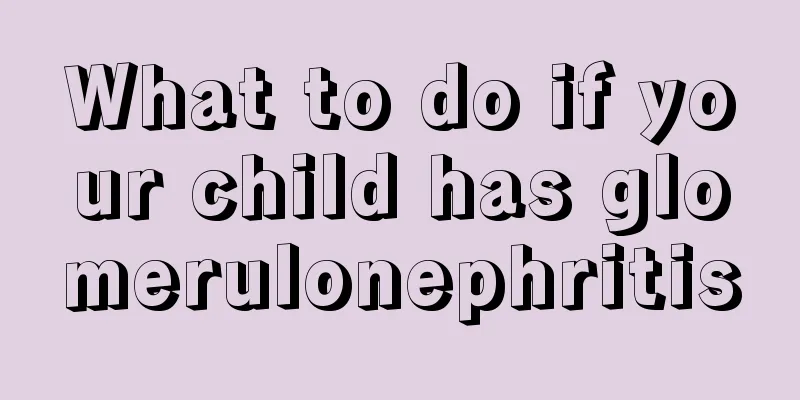What to do if your child has glomerulonephritis

|
What to do if children have glomerulonephritis? The family members of the sick children would really like to know the answer to this question. So what symptoms will a child have after suffering from childhood glomerulonephritis? What are the treatments for glomerulonephritis in children? Next, this article will start from these two aspects to introduce what to do if children have glomerulonephritis. Friends who want to know the relevant knowledge can take a look. 1. Symptoms of glomerulonephritis in children 1. The onset is slow and the early symptoms are not obvious, manifested as mild edema (face and upper eyelids), slightly pale complexion, fatigue, loss of appetite, dizziness, etc. 2. The disease progresses slowly, the condition often recurs, and the symptoms vary from mild to severe. The condition is often aggravated or acute due to upper respiratory tract infection, enteritis, etc. Symptoms include edema, worsening systemic symptoms, azotemia, severe acidosis or electrolyte imbalance, hypertension, and even hypertensive encephalopathy and heart failure. There may be no symptoms or only mild symptoms during the intervals between attacks. 3. Persistent hypertension, mild edema and anemia are often the basic symptoms of chronic nephritis. 4. If the disease persists to the late stage, renal failure may occur, manifested by hypertension, progressive anemia, general weakness, dizziness, headache, visual impairment, nausea, vomiting, diarrhea, bleeding tendency and other symptoms of azotemia, uremia and acidosis. 5. Sometimes during the course of the disease, the patient may show symptoms of kidney disease, such as general edema, decreased urine volume, and normal or slightly elevated blood pressure. Some patients may show obvious symptoms of kidney disease at the onset of the disease. 6. The fundus may show changes such as exudative inflammation, hemorrhage, optic disc edema, and arterial spasm and tortuosity. Treatment of glomerulonephritis in children 1. General treatment and adequate rest. When the condition is stable, appropriate activities and exercises are allowed. When the condition is severe or during an acute attack, the patient should rest in bed. At the same time, it provides sufficient amounts of vitamin B complex and vitamin C. The diet is mainly focused on controlling salt and water. It should be restricted when there is high blood pressure or heart failure, but generally no strict restrictions are required. Provide a low-protein diet, mainly sugar and fat, to supplement calories. 2. Prevent infection. Since respiratory and intestinal infections can often induce renal failure, prevention should be actively carried out. If infection exists, it should be controlled in time. Drugs that cause great damage to the kidneys, such as kanamycin, polymyxin, gentamicin, etc., should be avoided as much as possible. Chronic infection lesions should be cured to reduce recurrence of the disease. 3. Traditional Chinese medicine treatment focuses on clearing away heat and dampness, and regulating the spleen and kidneys. Chen’s Nephritis Formula is often used. There is also a prescription: Anemarrhena asphodeloides 9g, Phellodendron chinense 9g, Dioscorea batatas 15g, Poria cocos 15g, Codonopsis pilosula 15g, Rehmannia glutinosa 15g, Alisma orientalis 9g. The following medicines can be added according to the symptoms: If there is palpitations, add 9g of duckweed. For oliguria, add 30g of red beans and 15g of plantain. If symptoms of spleen and kidney failure (uremia) appear, the treatment is to support Yin and promote the flow of qi, and Fu Zi Li Zhong Tang with alkali is often used. Prescription: Aconite 9g, Cinnamon 4.5g, Codonopsis pilosula 15g, Poria 15g, Tangerine peel 9g, Magnolia officinalis 4.5g, Rhubarb 6g, Pinellia 9g. The above is an introduction to the treatment methods of glomerulonephritis in children. I believe that after reading the above introduction, you will have a better understanding of the relevant knowledge about glomerulonephritis in children and know what to do with glomerulonephritis in children. This knowledge is helpful for the families of sick children. I hope that through the introduction of this article, everyone can understand more about the disease of glomerulonephritis in children. |
<<: What to do if your newborn refuses to sleep
>>: What to do if your newborn gets angry
Recommend
How to treat baby's rotten feet
There are many reasons for baby's sore feet. ...
What to do if your child always bites his lower lip
Children will always encounter various problems d...
What should I do if my child has white spots on his face?
When a child has white spots on his face, this is...
Causes of blisters in the middle of the baby's upper lip
Many mothers will find that bubbles appear in the...
Why does the baby toss and turn when sleeping at night?
There are many common problems for babies. To sol...
What should I do if my child is slow in doing homework?
Many children will dawdle when doing their homewo...
What are some ways to supplement calcium for children?
Many people usually pay attention to the issue of...
The child is awake and coughing
Some children are prone to coughing after waking ...
Herpes in the throat of a child
The throat usually does not get sick, but many ch...
5 nutritious breakfasts for kids
A year's plan starts with spring; a day's...
Causes and treatment suggestions for red bloodshot eyes in newborns
Bloodshot eyes are a problem even for adults, so ...
Is it appropriate to wean your baby at ten months?
When to wean the baby is a question that troubles...
Can children with cold and fever drink milk?
When children have a cold or fever, many dietary ...
Reasons and related introductions for snoring in two-month-old babies
We all know that snoring is caused by poor breath...
What should children eat in autumn?
As autumn approaches, the climate begins to becom...









